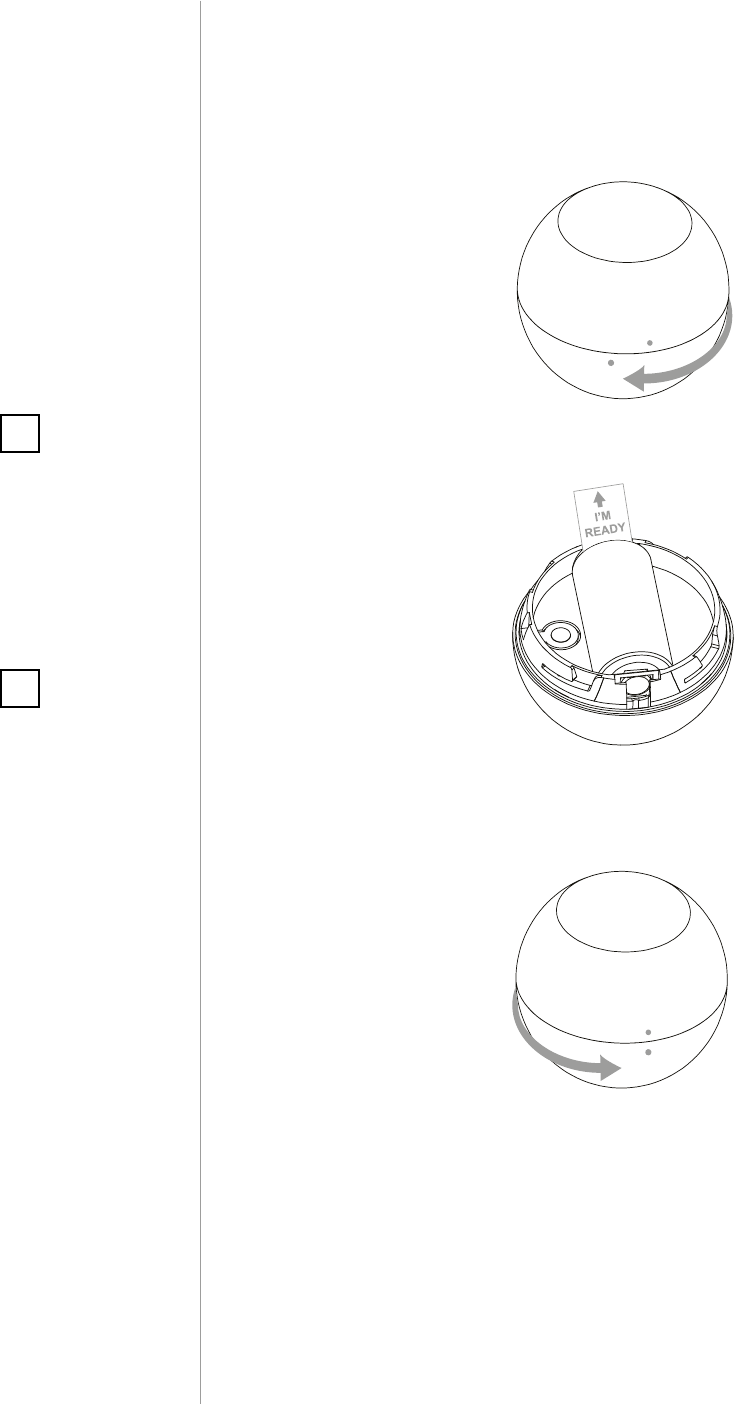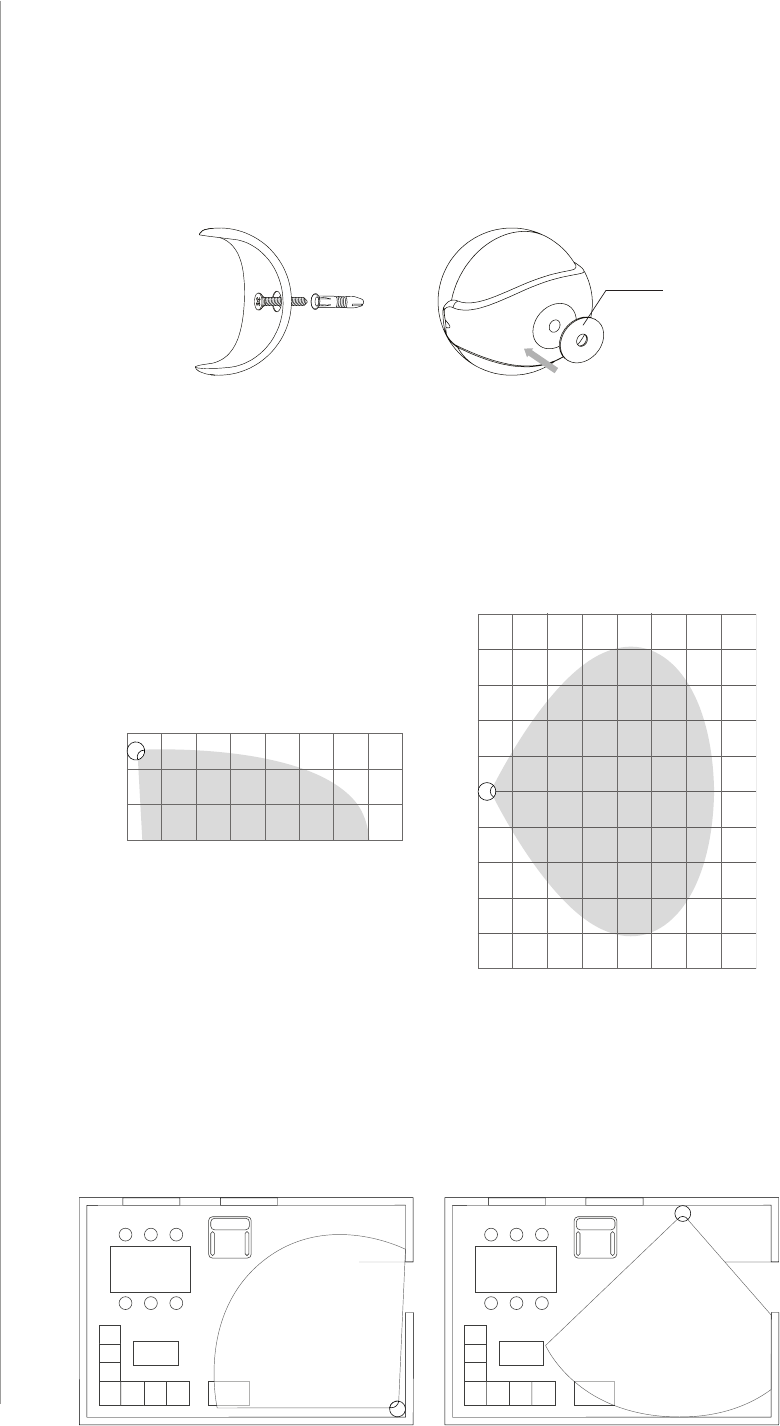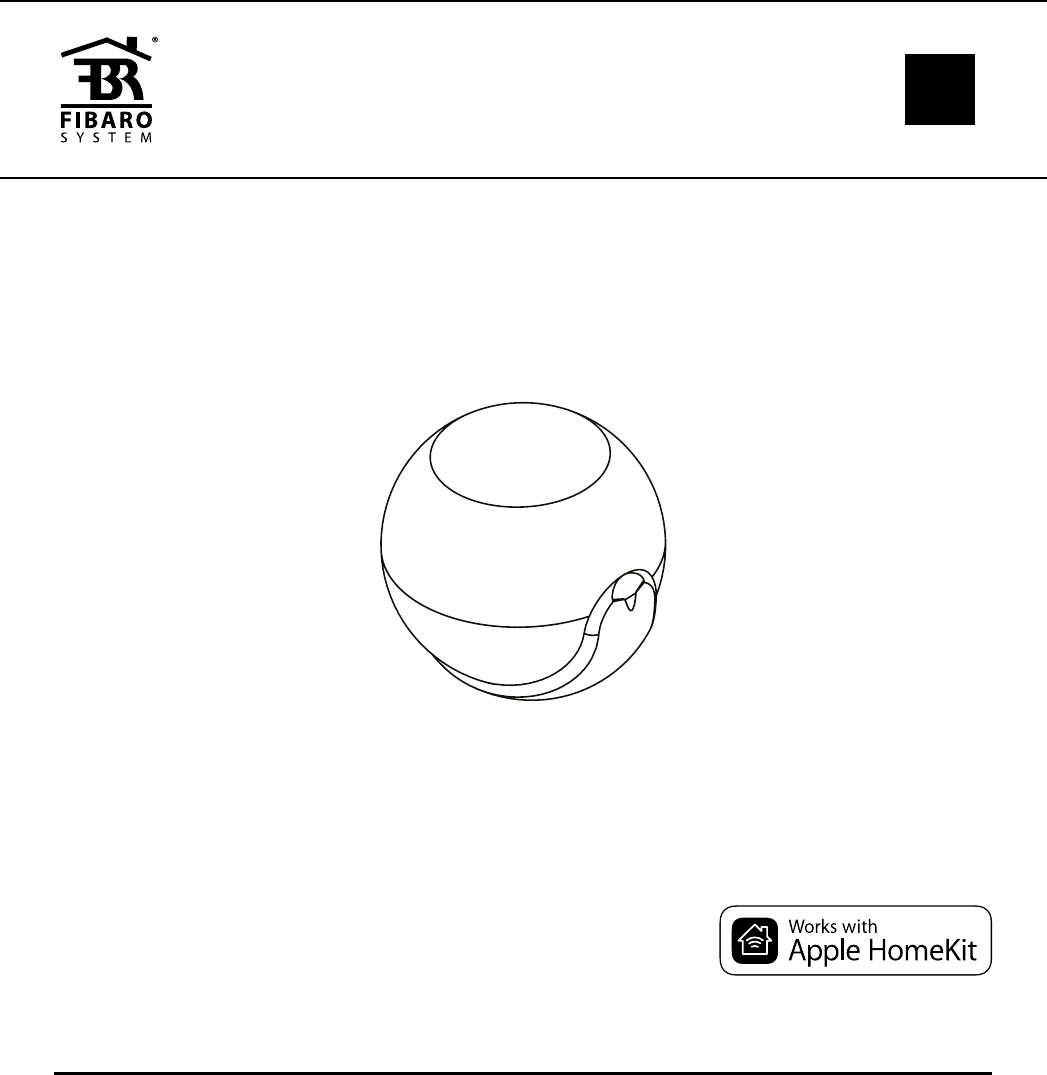Fibar Group FGBHMS001 Motion Sensor User Manual
Fibar Group S.A. Motion Sensor
User Manual

2
Important safety information
Read this manual before attempting to install the device!
Failure to observe recommendations included in this manual
may be dangerous or cause a violation of the law. The manufacturer,
Fibar Group S.A. will not be held responsible for any loss or damage
resulting from not following the instructions of operating manual.
!
HomeKit technology
Apple HomeKit technology provides an easy, secure way to control
HomeKit-enabled accessories using Siri on your iPhone, iPad, or iPod
touch.
After installing your FIBARO Motion Sensor, congure it from a
compatible app with just a few simple steps.
You can even create your own custom scenes to control your home
settings. For example, you can create a scene to automatically turn
o the lights, lock your doors, close the garage door, and set the
thermostat to the desired temperature in just one step.

3
DESCRIPTION AND FEATURES
Main features of FIBARO Motion Sensor:
• compatible with Apple HomeKit technology
• Bluetooth® low energy technology for wireless communication
• detects motion using a passive IR sensor
• measures ambient temperature
• measures light intensity
• detects tampering using accelerometer
• easy installation
• may be installed anywhere - wall or any surface
• battery powered
• indicates state using multicolor LED diode
FIBARO Motion Sensor is a HomeKit-enabled multi-sensor using
Bluetooth® low energy technology.
Along with detecting motion, the accessory measures the ambient
temperature and light intensity.
The sensor has a built-in accelerometer to detect any tampering with
the accessory.
FIBARO Motion Sensor is battery powered and designed to be
installed quickly and easily on any surface.
The eye-shaped LED indicator signals motion, temperature level,
tampering and can be used to identify the accessory.
#1: Description and features
NOTE
Controlling this
HomeKit-enabled ac-
cessory requires an
iPhone, iPad, or iPod
touch with iOS 9.3 or
later.
Controlling this
HomeKit-enabled ac-
cessory away from
home requires a
third-generation
Apple TV with Apple TV
software 7.2.1 or later
or a fourth generation
AppleTV with tvOS 9.2
or later and an iPhone,
iPad, or iPod touch
with iOS 9.3 or later
i

4
POWERING THE ACCESSORY
#2: Powering the accessory
1. Turn the cover counter-clockwise and open it.
2. Remove the battery blocker and check if the battery is placed cor-
rectly.
3. The accessory will glow red – it is ready to be paired.
4. Close the cover and turn it clockwise, dots on the casing should
align.
NOTE
Remember to use
only battery type
specied in the man-
ual and keep the right
polarity.
i
NOTE
If the accessory blinks
green after powering,
it is already paired and
has to be reset to pair
again.
i

5
PAIRING THE ACCESSORY
#3: Pairing the accessory
1. Open the Settings app on your iOS device.
2. Go to the Bluetooth® section, and turn the Bluetooth® on.
3. Place the accessory next to your iOS device.
4. Open a HomeKit app of your choosing on your iOS device.
5. Open pairing window in your HomeKit app to detect available
accessories.
6. Choose Motion Sensor you wish to pair.
7. You can identify it - Motion Sensor will triple blink blue 3 times.
8. Find HomeKit Setup Code on the last page of user manual includ-
ed in the box that looks like this:
9. Start pairing with your HomeKit app.
10. Point your iOS device’s camera at the Setup Code to scan it or en-
ter the Setup Code manually.
11. If entered Setup Code is valid, the device will complete the setup
process.
12. Follow instructions displayed in the application.
NOTE
Use Fibaro app to ful-
ly utilize this product.
Other HomeKit com-
patible apps might
not support all of its
features.
i
XXX-XX-XXX
NOTE
Remember to keep
your HomeKit Setup
Code in safe place. You
may need it in case of
re-pairing.
i

6
PHYSICAL INSTALLATION
#4: Physical installation
Installing the Motion Sensor:
1. Install the holder (using an expansion bolt or a sticker).
2. Insert the device into the holder.
3. Test the operation - check whether the device indicates motion
detection.
Detection range:
Detection range of the Motion Sensor is shown below. Actual range
of the Sensor can be inuenced by environmental conditions.
0 m
5 m
5 m
7 m
Installation location and working conditions:
The Motion Sensor should be installed in a corner of the room or per-
pendicularly to the doors.
Moving objects such as trees blowing in the wind, cars passing by,
household fans and moving masses of air and heat within detection
area of the sensor can cause false motion detection.
Sticker
0 m
3 m
7 m

7
RESET
Resetting the Motion Sensor to factory defaults:
Reset procedure allows to restore the accessory back to its factory
settings including HomeKit pairing. We recommend performing re-
setting procedure within range of your iOS device’s Bluetooth®.
1. Open the cover.
2. Press and hold the button.
3. Wait for the LED indicator to glow yellow.
4. Release the button.
5. Click the button to conrm.
6. After resetting the accessory will glow red - it is ready to be paired
again.
NOTE
If reset procedure
was performed out-
side iOS device’s
Bluetooth® range the
accessory will not be
removed from the
HomeKit app and will
not respond. In this
case remove the de-
vice manually from
the app.
i
Button
#5: Reset

8
FUNCTIONALITIES
#6: Functionalities
Motion detection:
The Motion Sensor detects movement using PIR sensor and reports it
to your iOS device.
Blink of LED indicates detected motion. Color of blink is dependent on
current ambient temperature (smooth transition through blue, green
and red). Brightness of blink is adjusted by measured light intensity.
Tamper detection:
The Motion Sensor detects tampering when accessory is moved and
reports it to your iOS device. Tampering is indicated with an alternate
blinking in red, blue and white.
Temperature measuring:
The Motion Sensor measures ambient temperature every 5 min-
utes. If the measured temperature diers from previously reported
by at least 2°C (3.6°F), accessory reports it to your iOS device.
Battery level measuring:
The Motion Sensor measures battery level every 24 hours and reports
it to your iOS device. Additionally, if battery level is below 15%, the
accessory will report low level battery status to your iOS device.
Light intensity measuring:
The Motion Sensor measures light intensity. If the measured light in-
tensity diers from previously reported by at least 200 lux, accessory
reports it to your iOS device.
NOTE
If you are using Fibaro
app you can adjust
sensitivity, sustain
time and LED indica-
tion for motion detec-
tion using parameters.
i
NOTE
If you are using Fibaro
app you can adjust
sensitivity and indica-
tions for tamper de-
tection using param-
eters.
i
NOTE
The accessory mea-
sures light intensity
in the place of instal-
lation, not where the
sensor is pointed.
i
NOTE
The accessory mea-
sures temperature in
the place of installa-
tion. Remember that
temperature near
the ceiling may dier
from that on eye-level
or the oor.
i

9
CONFIGURABLE PARAMETERS
#7: Congurable parameters
1. Motion detection – sensor sensitivity
This parameter allows to set sensitivity of PIR sensor used for motion
detection.
The higher the value of this parameter, the higher the sensitivity.
Available settings: 1 – low sensitivity
2 – medium sensitivity
3 – high sensitivity
Default setting: 2 (medium sensitivity)
2. Tamper – sensor sensitivity
This parameter allows to set sensitivity of tamper detection.
The higher the value of this parameter, the higher the sensitivity.
Available settings: 0 – tamper disabled
1 – low sensitivity
2 – medium sensitivity
3 – high sensitivity
Default setting: 2 (medium sensitivity)
3. Motion detection – LED indication
This parameter allows to choose how the LED indicator will behave
after detecting motion.
Available settings: 0 – LED indications disabled
1 – color dependent on temperature*
2 – ashlight mode**
3 – white, 4 – red, 5 – green, 6 – blue, 7 – yellow,
8 – cyan, 9 – magenta
Default setting: 1 (color dependent on temperature)
4. Tamper – LED indication
This parameter allows to choose if accessory will indicate tampering
using LED (alternate blinking in red, blue and white).
Available settings: 0 – tamper indication disabled
1 – tamper indication enabled
Default setting: 1 (tamper indication enabled)
NOTE
* Color is a smooth
transition from blue
through green to
red in range 18-30°C
(64.4-86°F).
** In ashlight mode
the LED provides
white light with high-
er brightness.
i

10
CONFIGURABLE PARAMETERS
5. Motion detection - sustain time
This parameter allows to set how long the information about detect-
ed motion is sustained by the accessory. Each subsequent motion de-
tection causes time to be counted from the beginning.
Available settings: 1-32767 – sustain time in seconds
Default setting: 30 (30 seconds)

11
SPECIFICATIONS
#8: Specications
Power supply:
Battery type:
EU directives compliance:
Radio protocol:
Radio frequency:
Range:
Recommended
installation height:
Operating temperature:
Temperature measuring
range:
Temperature measuring
accuracy:
Light intensity measuring
range:
Dimensions (diameter):
3.0V DC battery
CR123A
R&TTE 1999/5/EC
RoHS 2011/65/EU
Bluetooth® low energy
2.4 GHz
up to 50m (free range)
(164 feet)
2.4 meters (7.87 feet)
0-40°C (32-104°F)
0-40°C (32-104°F)
±0.5°C (±0.9°F)
0-32000 lux
46 mm (1.8 inch)
CAUTION
Using batteries other
than specied may
result in explosion.
Dispose of properly,
observing environ-
mental protection
rules.
!

12
REGULATIONS
#9: Regulations
This device complies with Part 15 of the FCC Rules
Operation is subject to the following two conditions:
1. This device may not cause harmful interference
2. This device must accept any interference received, including inter-
ference that may cause undesired operation. This equipment has been
tested and found to comply with the limits for a Class B digital device,
pursuant to part 15 of the FCC Rules. These limits are designed to pro-
vide reasonable protection against harmful interference in a residen-
tial installation. This equipment generates, uses and can radiate radio
frequency energy and, if not installed and used in accordance with the
instructions, may cause harmful interference to radio communications.
However, there is no guarantee that interference will not occur in a par-
ticular installation. If this equipment does cause harmful interference
to radio or television reception, which can be determined by turning
the equipment o and on, the user is encouraged to try to correct the
interference by one or more of the following measures:
• Reorient or relocate the receiving antenna.
• Increase the separation between the equipment and receiver.
• Connect the equipment into an outlet on a circuit dierent from
that to which the receiver is connected.
• Consult the dealer or an experienced radio/TV technician for help.
Note
Changes and modications not expressly approved by the manufac-
turer or registrant of this equipment can void your authority to operate
this equipment under Federal Communications Commission’s rules.
Industry Canada (IC) Compliance Notice
This device complies with Industry Canada license-exempt RSSs. Oper-
ation is subject to the following two conditions: (1) this device may not
cause interference, and (2) this device must accept any interference, in-
cluding interference that may cause undesired operation of the device.
Cet appareil est conforme aux normes d’exemption de licence RSS d’In-
dustry Canada. Son fonctionnement est soumis aux deux conditions
suivantes : (1) cet appareil ne doit pas causer d’interférence et (2) cet
appareil doit accepter toute interférence, notamment les interférences
qui peuvent aecter son fonctionnement.
Radio frequency (RF) exposure statement
This equipment should be installed and operated keeping the radiator
at least 20 cm or more away from person's body.
Cet équipement doit être installé et utilisé en gardant une distance de
20 cm ou plus entre le dispositif rayonnant et le corps.

13
REGULATIONS
DGT Warning Statement
Article 12
Without permission, any company, rm or user shall not alter the fre-
quency, increase the power, or change the characteristics and func-
tions of the original design of the certied lower power frequency elec-
tric machinery.
Article 14
The application of low power frequency electric machineries shall not
aect the navigation safety nor interfere a legal communication, if an
interference is found, the service will be suspended until improvement
is made and the interference no longer exists.
第十二條
經型式認證合格之低功率射頻電機,非經許可,公司、商號或使用
者均不得擅自變更頻率、加大功率或變更原設計之特性及功能。
第十四條
低功率射頻電機之使用不得影響飛航安全及干擾合法通信;經發現
有干擾現象時,應立即停用,並改善至無干擾時方得繼續使用。
前項合法通信,指依電信法規定作業之無線電通信。
低功率射頻電機須忍受合法通信或工業、科學及醫療用電波輻射性
電機設備之干擾。
Legal Notices
All information, including, but not limited to, information regarding the
features, functionality, and/or other product specication are subject
to change without notice. Fibaro reserves all rights to revise or update
its products, software, or documentation without any obligation to no-
tify any individual or entity.
FIBARO and Fibar Group logo are trademarks of Fibar Group S.A.
The Bluetooth word mark and logos are registered trademarks owned
by Bluetooth SIG, Inc. and any use of such marks by Fibar Group S.A. is
under license.
Apple, iPhone, iPad, iPad Air, and iPod touch are trademarks of Apple
Inc., registered in the U.S. and other countries. HomeKit is a trademark
of Apple Inc.
All other brands and product names referred to herein are trademarks
of their respective holders.
Use of the Works with Apple HomeKit logo means that an electronic
accessory has been designed to connect specically to iPod, iPhone, or
iPad, respectively, and has been certied by the developer to meet Ap-
ple performance standards. Apple is not responsible for the operation
of this device or its compliance with safety and regulatory standards.
Declaration of conformity
Hereby, Fibar Group S.A. declares that FIBARO Motion Sensor
is in compliance with the essential requirements and oth-
er relevant provisions of Directive 1999/5/EC.
